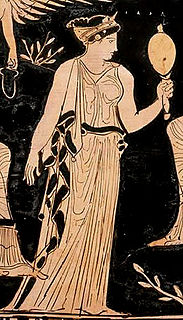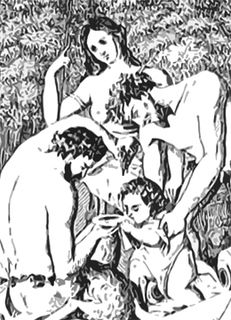Related Research Articles

Iaso or Ieso was the Greek goddess of recuperation from illness. The daughter of Asclepius, she had four sisters: Aceso, Aglæa/Ægle, Hygieia, and Panacea. All five were associated with some aspect of health or healing. For more information on the genealogy of Iaso, see Panacea.
The panacea, named after the Greek goddess of universal remedy Panacea, is any supposed remedy that is claimed to cure all diseases and prolong life indefinitely. It was in the past sought by alchemists in connection with the elixir of life and the philosopher's stone, a mythical substance which would enable the transmutation of common metals into gold.

Asterix Versus Caesar is a 1985 French–Belgian animated adventure comedy film written by René Goscinny, Albert Uderzo and Pierre Tchernia, and directed by Paul and Gaëtan Brizzi, and is the fourth film adaptation of the Asterix comic book series. The story, an adaptation that combines the plots of Asterix the Legionary and Asterix the Gladiator, sees Asterix and his friend Obelix set off to rescue two lovers from their village that had been kidnapped by the Romans. The film's theme song, Astérix est là, was composed and performed by Plastic Bertrand.

Mathis Mootz is a prolific German electronic musician and DJ. Mootz is best known as The Panacea, his drum and bass stage name and main musical project, and as m2, his dark ambient side project and alter-ego.
Aceso was the Greek goddess of the healing process.
Hyaleucerea is a genus of moths in the subfamily Arctiinae. The genus was erected by Arthur Gardiner Butler in 1875.

In Greek mythology, Panacea was a goddess of universal remedy and the daughter of Asclepius and Epione. Panacea and her four sisters each performed a facet of Apollo's art:
Hyaleucerea chapmani is a moth of the subfamily Arctiinae. It was described by Edward A. Klages in 1906. It is found in Venezuela.
Hyaleucerea gigantea is a moth of the subfamily Arctiinae. It was described by Herbert Druce in 1884. It is found in Guatemala and Panama.
Hyaleucerea leucoprocta is a moth of the subfamily Arctiinae. It was described by Paul Dognin in 1909. It is found in French Guiana.
Hyaleucerea leucosticta is a moth of the subfamily Arctiinae. It was described by Druce in 1905. It is found in Venezuela.
Hyaleucerea lugubris is a moth of the subfamily Arctiinae. It was described by Schaus in 1901. It is found in Colombia.
Hyaleucerea manicorensis is a moth of the subfamily Arctiinae. It was described by Rego Barros in 1971. It is found in Brazil.
Hyaleucerea ockendeni is a moth of the subfamily Arctiinae. It was described by Rothschild in 1912.
Hyaleucerea phaeosoma is a moth of the subfamily Arctiinae. It was described by George Hampson in 1905. It is found in Paraguay.
Hyaleucerea sororia is a moth of the subfamily Arctiinae. It was described by Schaus in 1910. It is found in Costa Rica.
Hyaleucerea trifasciata is a moth of the subfamily Arctiinae. It was described by Arthur Gardiner Butler in 1877. It is found in the Amazon region.
Hyaleucerea uniformis is a moth of the subfamily Arctiinae. It was described by Rothschild in 1912.
Pezaptera chapmani is a moth of the subfamily Arctiinae. It was described by Edward A. Klages in 1906. It is found in Venezuela.
The Euchromiina are a subtribe of tiger moths in the family Erebidae. It was described by Arthur Gardiner Butler in 1876. Many species in the subtribe are mimics of wasps.
References
- ↑ Beccaloni, G.; Scoble, M.; Kitching, I.; Simonsen, T.; Robinson, G.; Pitkin, B.; Hine, A.; Lyal, C., eds. (2003). "Hyaleucerea panacea". The Global Lepidoptera Names Index . Natural History Museum . Retrieved May 6, 2018.
| This Euchromiina-related article is a stub. You can help Wikipedia by expanding it. |